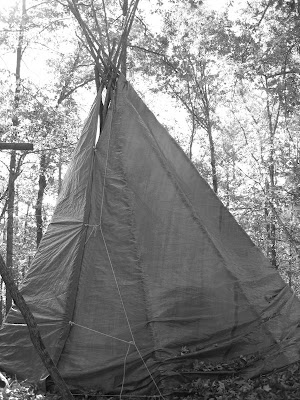
Heres how to make a simple bow from a single piece of wood, what is called a selfbow. I didnt document the whole process with pictures but will add some when doing my next bow.
-First you'll want to start by finding a clean looking, straight tree of about 4" diameter, free of knots and twists. Most hardwood will make a great bow- oak, hickory, elm, ash, walnut, locust, dogwood,etc. If you have no local wood available you can buy a red oak board at home depot for $10. Choose one with the straightest grain.
-Harvest your chosen tree and cut it roughly to length leaveing a few extra inches to play with, 64-68" final length is good for a longbow, but you can easily go 72" or more.
-With a wedge or axehead, split the tree in half,or quarters if the diameter is large enough. When the head is in far enough you can insert a log and use that to finish splitting. The bark side will be the back of the bow (side facing away from you when shooting), the inside is called the belly.
-Remove only the bark and little wood from the back just until its flat, the belly is where you'll be removing the majority of wood- aiming for a width of about 2", shave the sides flat
-Now remove wood from the belly until its parellel to the back. Once the front and back are even, narrow the sides to a final width of about 1-1/2", and taper the last 8" of the limbs.
Always go slow, being in a hurry ruins bows. Stop often to feel out the bow by running your fingers back and forth in all areas to get a good feel for what the bow is doing.
-Hold the bow with your arms out and mark it at the center of your chest. Mark about a finger length on either side to allow for the grip area.
Tillering your bow-With an axe or knife, begin shaving off wood from the belly taking note of the thickness and curve of the bow. Always follow the grain and natural twists, it will be stronger.
-Periodically check the tiller by flexing one end of the bow into the ground, you want it to bend evenly in a semi circle across its entire length, it will store the most energy and stress the least this way- once you have about the right tiller, leave some extra wood on the bow and put it up to dry in a warm area for at least 3-4 weeks, until it no longer feels cold to the touch on your face, then you can finish tillering and then sand and finish your bow.
Keep in mind the more you bend wet wood the more 'set' it will develop, meaning the limbs will naturally start to bend back, which will decrease their range of motion thus hinder performance. so dont go too far when tillering until its cured for several weeks.
If you leave it unfinished i.e. not sealed with a coating of some type, its moisture content will change depending on weather, so willbe more sluggish in humid weather and will be faster with a heavier pull in dry weather. finishing your bow with a protective coating like minwax polyurethane will seal in the moisture content and yeild a more consistent bow. You can use animal fat, linseed oil, beeswax etc. for a more natural look.
Its not a shame to sacrifice a good tree if you honor its life by crafting it into worthy bow that will see many years of use. Remember everything you take from nature is a gift, so i like to be humble and treat it with respect.
For a string, 550 parachute cord works great. If you want to go primitive and fashion your own string from leather or sinew, thatll work too. Whatever you use, make sure its test strength be at least 4 times stronger than the pull weight of your bow.
You can make or buy a tillering board. This is a very helpful device for checking tiller and measuring draw weight. Cut a notch in the top of a 1x4 to hold the bow, then cut notches in 1" graduations. By setting this on a bathroom scale you can accurately measure the weight of the draw at different draw lengths.

Freshly split staves.
Heres a couple ways you can tie the string, a double-loop and bowyer's knot.



Checking tiller- remove wood from the areas that dont bend enough.

Carve grooves for the string, narrow and thin the tips for a stronger, faster shooting bow. More energy will go to moving the arrow instead of wasted on moving the tips.
Tillering board


You can carve grooves in the handle to fit your hand better, and wrap with string for comfortable grip.

My first bow, made of white oak, stained with a walnut finish.
I hope this inspires others to experience the fun of making your own bow. With only a couple dollars and some patience you can end up with a very capable bow for target shooting or hunting, and the feeling you get of a connection to the earth and ancient times is very satisfying.
Ill do a primitive arrow build along next, im drying out some saplings that should be ready soon.




































 Mark a rough outline of the spoon shape, with your knife or pencil, and whittle down to size alternating between knife and axe as needed.
Mark a rough outline of the spoon shape, with your knife or pencil, and whittle down to size alternating between knife and axe as needed.



